Toyota Corolla (E170) 2014–2019 Owners Manual / Maintenance and care / Do-it-yourself maintenance / Checking and replacing fuses
Toyota Corolla (E170): Checking and replacing fuses
If any of the electrical components do not operate, a fuse may have blown. If this happens, check and replace the fuses as necessary.
1 Turn the engine switch off.
2 Open the fuse box cover.
► Engine compartment Push the tab in and lift the lid off.
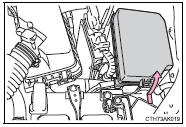
► Under the driver’s side instrument panel Remove the lid.
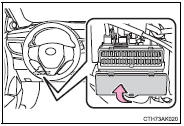
3 Remove the fuse with the pullout tool.
Only type A fuses can be removed using the pullout tool.
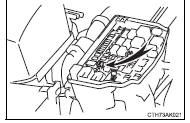
4 Check if the fuse is blown.
1 Normal fuse
2 Blown fuse
Replace the blown fuse with a new fuse of an appropriate amperage rating.
The amperage rating can be found on the fuse box lid.
► Type A
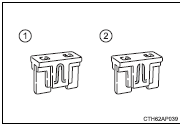
► Type B
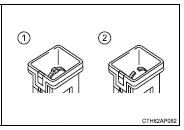
► Type C
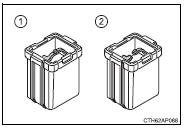
■After a fuse is replaced
●If the lights do not turn on even after the fuse has been replaced, a bulb
may need replacement.
●If the replaced fuse blows again, have the vehicle inspected by your Toyota dealer.
■If there is an overload in a circuit
The fuses are designed to blow, protecting the wiring harness from damage.
CAUTION
■To prevent system breakdowns and vehicle fire
Observe the following precautions.
Failure to do so may cause damage to the vehicle, and possibly a fire or injury.
●Never use a fuse of a higher amperage rating than that indicated, or use any other object in place of a fuse.
●Always use a genuine Toyota fuse or equivalent.
Never replace a fuse with a wire, even as a temporary fix.
●Do not modify the fuses or fuse boxes.
NOTICE
■Before replacing fuses
Have the cause of electrical overload determined and repaired by your Toyota dealer as soon as possible.
Other materials:
Checking and replacing fuses
If any of the electrical components
do not operate, a
fuse may have blown. If this
happens, check and replace
the fuses as necessary.
Checking and replacing
fuses
1. Turn the engine switch off.
2. Open the fuse box cover.
Engine compartment: type A
fuse box
Push the tabs in and lift the lid off.
E ...
Circuit description
The throttle pressure that is applied to the primary regulator
valve (which modulates the line pressure) causes the solenoid
valve slt, under electronic control, to precisely and minutely
modulate and generate the line pressure according the extent
of the accelerator pedal depressed or the o ...
Rear view monitor system
The rear view monitor system assists the driver by displaying guide lines
and an image of the view behind the vehicle while backing up, for example while
parking.
The screen illustrations used in this text are intended as examples, and may
differ from the image that is actually displayed on t ...


